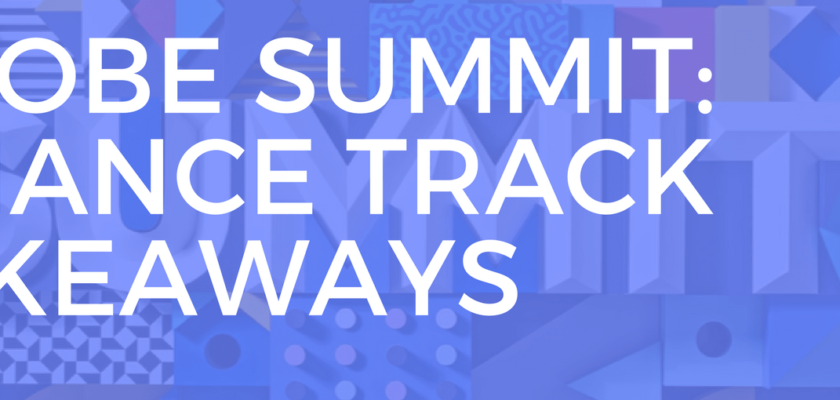Here’s What you Missed from the Finance Track at the Adobe Summit 2018

With all the hustle and bustle of the Adobe Summit, it’s hard to remember all the advice and insights amongst checking out all the amazing booths and grabbing yourself some great swag. But don’t worry, if you forgot to take notes or couldn’t make it out to the event, we’ve got you covered!
Summit’s Finance and Insurance Track featured industry leaders from Citizen Bank, US Bank AND National Bank who shared what it means to be customer-centric in fintech. The common theme in these sessions was that it’s not enough to have the best product out on the market if the customers aren’t top of mind. We heard first hand how these industry leaders have struggled and strived through these changing times and customer expectation.
The Taplytics team was on the ground taking it all in and thought we would share our fintech track takeaways with you.
p.s. Want to make your fintech/finserve app better? Get a free assessment from our team of experts.
A Personal Touch Goes a Long Way
Back when Henry Ford was building his empire, his thought process was simple, “ Any customer can have a car painted any color that he wants so long as it is black.” This worked because he was pioneering the revolution of transportation and options were limited. But we’re far from the early 1900’s, there’s more innovation than invention and an ocean of choices for consumers to pick from. How are you supposed to compete? Sarah Steidinger from Citizen Bank says it’s all about personalization.
“84% of marketers are just starting out around personalization – only 6% see themselves as advanced”
Considering that consumers have been demanding more personalized and humanized experiences for quite some time now, it was quite shocking to learn that companies are just starting to listen. If companies can master personalization early in the game, it could very well keep them on top.
It’s no surprise that customers want to feel special, but where companies struggle is the how. It’s not all about painting the car another colour like Henry Ford, rather a focus on personalizing every touchpoint. Everything from push notifications, emails, special offers, onboarding, special offers needs to feel special and catered to individual customers.
This is especially important in fintech, where earning customer trust is absolutely essential. Read here about how fintech apps like Capital One, Robinhood, Digit, and Venmo prioritize both security and simplicity in their UX design to build user loyalty.
Your customers are humans. Treat them that way!
It’s easy to get caught up in all of the new technology and talk around data and automation and forget that at the end of the day your customers are human. They aren’t just numbers on your dashboard. Marisa Nelson from the US Bank reminds us that all this great technology should be used to humanize the customer experience rather than take away from it.
“Devices don’t buy things, people do.”
This doesn’t mean you should ignore the data and the dashboards. All of those metrics and numbers are valuable to help you better understand your customers and how you should create experiences for them.
Marisa draws upon the US Bank’s outlook and strategy on this issue. They first needed to create what she called a “lake of data” in order to bridge the gap between on and offline experiences. The US Bank realized that in order to put the customer first, they must understand who they’re talking to above all else. They attribute the success of their cross-platform strategy to the data they’ve been tracking and utilizing to make the customer experience more personalized.
There’s been a lot of debate and hesitance around the integration of AI and if it pushes the envelope a little too much. As with any new technology, it’s easy to run scared from it, rather than embracing its potential. Technology isn’t the enemy, but a tool that will help you automate what needs to be automated, so you have more time to humanize and personalize the experience. Technology isn’t a replacement, it simply helps you move the small rocks, so you can focus on what matters most, the customers.
If there is one important thing to take away from Marisa’s talk, it’s her caution to stop marketing to a series of devices, but to start thinking about the person behind each device.
Empowering Employees with Experimentation
We’re all aware of how experimentation can inch the products closer to optimization, but we seem to be overlooking the other benefits. National bank’s Eric Thibeault shared his story on how A/B testing empowered employees across the organization.
With today’s technology-driven processes, we can’t imagine living without our IT or engineering departments. What’s so powerful about modern A/B testing technology is that it empowers other departments to move forward without having their hand held the entire time.
“The right framework enabled us to take a idea to production much faster without IT.”
The right experimentation tool and framework should empower your team and give them the autonomy to move without technical roadblocks. Eric noted that “data is useless unless you act on it.” With a great dependency on IT to build experiments, it’s common for the data to lose its meaning by the time they’re able to help. The right tool will make it so that you no longer feel like you need a degree in engineering or analytics to understand how to best serve the customers and optimize their experience.
With consumer behavior changing and evolving rapidly, the speed and confidence needed to iterate are crucial to survival. A team confident in continuous experimentation and pivoting accordingly is what will shape an informed customer experience.
Building an experimentation isn’t difficult, it just takes a full commitment from the whole organization! Check out these 5 steps that can help you get started.
The Golden Rule
If we’ve learned anything from the Adobe Summit and the stories from Citizen Bank, US Bank, and National Bank is that we all have a long ways to go in using modern technology to its full potential. But what has stood the test of time is the golden rule; putting the customer at the center of it all.
We can all learn from each other’s mistakes and grow together and Sarah, Marisa, and Eric just added to the collection of lessons that we need to keep in mind moving forward to build great customer experiences in Fintech.
- Personalize your experience for each customer to build trust and loyalty.
- Treat your customers like humans!
- Increase the speed and confidence of experimentation to empower your team to create informed, delightful customer experiences.
